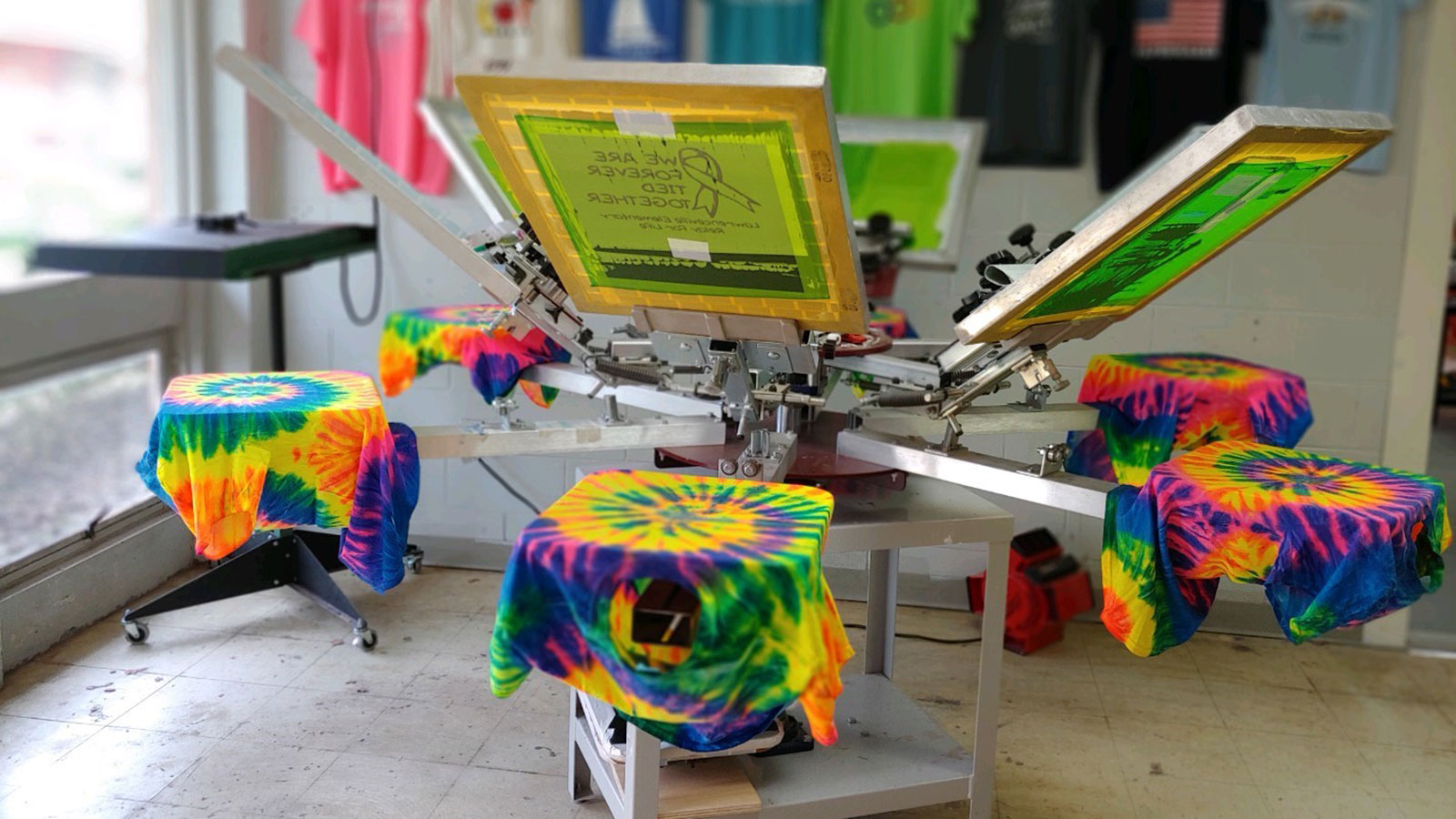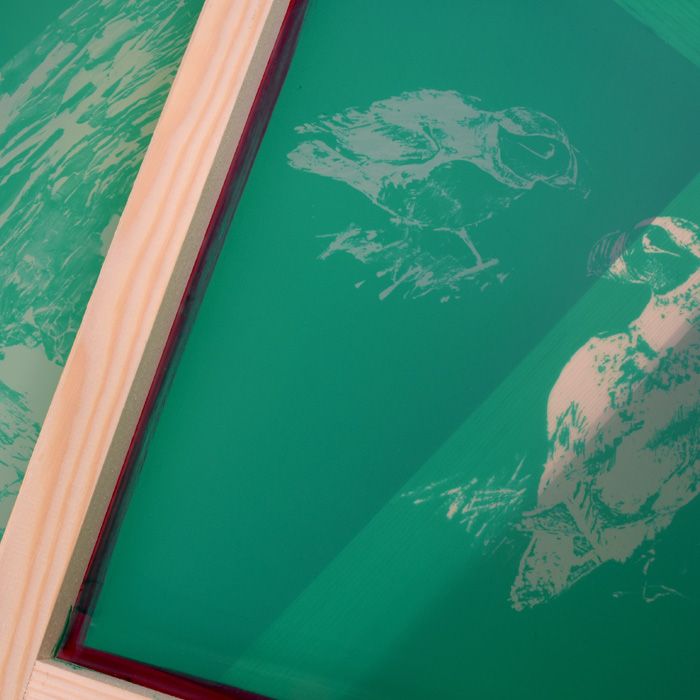Durable T-Shirt Printing for Everyday Wear
Wiki Article
Display Printing Uncovered: Everything You Need to Understand About Tee and Garment Printing Techniques
If you have actually ever wondered how those dynamic styles wind up on your preferred tee shirts, you remain in the ideal area. Display printing is a fascinating method that combines art with technique, providing limitless opportunities for creative thinking. Recognizing the fundamentals, from equipment to ink options, can considerably influence your outcomes. Prepared to check out the essential elements that make display printing an art type? Allow's reveal the information that can raise your jobs.
The Fundamentals of Screen Printing: Just How It Functions
When you dive into display printing, you'll discover it's both a scientific research and an art. At its core, screen printing entails creating a pattern, or screen, that permits ink to pass with just in certain areas.Following, you'll blend your inks and prepare your printing surface. Placement the screen over the textile, then make use of a squeegee to press ink through the display onto the garment. This procedure needs precision, as you desire clear, vibrant prints. After printing, you'll treat the ink with heat, guaranteeing it abides by the material and lasts via laundries. Each step is vital, and mastering them will certainly elevate your display printing skills, transforming basic garments into one-of-a-kind, meaningful items.
Types of Display Printing Techniques
As soon as you grasp the fundamentals of display printing, it's time to discover the numerous techniques that can raise your layouts. One preferred approach is conventional display printing, where ink is pressed with a stenciled display. This strategy is fantastic for strong, vivid shades. There's water-based ink printing, which provides a softer feel and is environment-friendly, yet it calls for a various strategy to healing.If you're going for great information, think about discharge printing. This technique gets rid of color from the fabric, leaving a soft, vintage look. Another choice is plastisol printing, known for its resilience and vibrant shades, making it a preferred for numerous brands. Lastly, explore halftone printing to develop slope results and intricate designs. Each method has its distinct charm, so do not wait to try them bent on discover what fits your style best!
Essential Tools for Screen Printing
To accomplish magnificent results in screen printing, having the ideal tools is basic. You'll require a sturdy screen printing frame, which holds the mesh that transfers your design onto the garment. Next, invest in premium mops; these are necessary for using ink equally throughout the display.Selecting the Right Inks and Materials
When choosing inks and materials for display printing, you require to take into consideration the kind of ink that functions ideal for your job. Consider material compatibility to ensure your styles look last and terrific long. Also, discover green ink alternatives to make your printing procedure a lot more sustainable.Kinds of Display Inks
Picking the ideal screen ink is essential for accomplishing vivid, sturdy prints that meet your project's needs. There are several types of display inks to analyze. Specialized inks, such as glow-in-the-dark or metal, can include one-of-a-kind effects to your styles.
Textile Compatibility Factors To Consider
Recognizing fabric compatibility is important for accomplishing premium display prints, particularly since different products respond uniquely to different inks. Constantly test your inks on example fabric to ensure they stick effectively and keep color stability. In addition, keep in mind that fabric weight and appearance can affect the last end result, so choosing the right ink and product combo is essential for your job's success.Eco-Friendly Ink Options
Environment-friendly inks are coming to be a popular choice for display printers who want to decrease their environmental impact while preserving high quality. When picking inks, think about water-based inks, which are less hazardous and much easier to cleanse up compared to conventional solvents.Furthermore, try to find inks made from eco-friendly sources, such as soy or vegetable-based alternatives. By choosing the ideal inks and products, you'll not only develop magnificent layouts however likewise add to a much more lasting printing process. Make the button, and your prints will certainly reflect your commitment to the setting!
Preparing Your Layout for Screen Printing

Submit Style Needs
To ensure your design looks sharp and vibrant on material, you'll require to pay close interest to submit format requirements for screen printing. Make sure your layout has a clear history to prevent unwanted white sides on your prints. Maintain color settings in mind; CMYK is typical for display printing, so transform your RGB creates as necessary.Shade Splitting Up Methods
Shade separation is an important action in preparing your style for display printing, and grasping it can significantly boost your print high quality. You'll require to break your layout into specific colors, as each shade requires have a peek at this website a different screen throughout printing. This precision not just guarantees precise color depiction yet additionally improves the printing procedure.Resolution and Size
Accomplishing the very best results in screen printing starts with ensuring your design has the appropriate resolution and size. Ideally, your art work ought to go to least 300 DPI (dots per inch) for sharp, clear prints. Your final product could look less than professional and pixelated. if you make use of lower resolution.When it pertains to dimension, consider the dimensions of your print location. Layout your art work to match the last print size, ideally developing it in the real dimensions you'll be printing. By doing this, you'll stay clear of any kind of unexpected scaling problems.
Constantly examine your design in both vector and raster formats. Vector graphics can be scaled without losing top quality, making them perfect for screen printing. Preparing properly will ensure your layout looks incredible on every garment!
Step-by-Step Screen Printing Process
Screen printing is a dynamic process that enables you to produce lively layouts on numerous surface areas. To get going, you'll require a display, solution, and your picked ink. Initially, prepare your display by cleansing it extensively. Next off, use the solution equally and allow it completely dry in a dark location. When dry, subject your screen to light with your design positioned on it, which will harden the emulsion where the light hits, creating a pattern - screen printing kit.Pour ink onto the screen and make use of a squeegee to push the ink through the pattern onto the material. Raise the display thoroughly and allow the print completely dry. You have actually successfully display published your style.
Tips for Effective Screen Printing Projects
While you're diving into your display printing jobs, keep in mind that preparation is crucial to success. Begin by collecting all your materials-- inks, screens, garments, and squeegees. A tidy work area aids avoid undesirable errors, so clean up prior to you start.Next, validate your artwork is high-resolution and properly sized for your garment. Test your display for appropriate direct exposure and tidy it completely to avoid smudges. When mixing your inks, adhere to the maker's standards to attain the right consistency.
During printing, use also stress with your squeegee for constant outcomes. Do not rush; take your time to confirm each print meets your criteria. After printing, allow your garments completely dry completely prior to taking care of or packaging them.
Last but not least, always maintain a sample of your work for future referral. In this manner, you can assess your development and enhance your techniques with time. Pleased printing!

Frequently Asked Inquiries
For how long Does It Take to Establish up a Display Printing Work?
Setting up a display printing work generally takes about half an hour to an hour. You'll prepare the displays, mix inks, and adjust journalism. The time differs based upon complexity and experience, so stay organized!Can I Print on Different Fabric Keys In Utilizing the Very Same Method?
Yes, you can publish on various fabric types utilizing the same technique, however you'll require to adjust your settings and inks. Some textiles soak up ink differently, so exploring assurances the finest outcomes for each and every material.What Are Common Blunders to Avoid in Screen Printing?
When screen printing, avoid typical blunders like using the wrong ink, neglecting correct exposure times, or missing pre-press checks. view website Constantly check your configuration and keep tidy displays to guarantee top quality outcomes each time.Just How Can I Correctly Tidy and Maintain My Screen Printing Equipment?
To properly clean and maintain your screen printing devices, you must consistently clean displays with appropriate solvents, examine mops for wear, and guarantee all tools are stored dust-free and completely dry. Uniformity prevents pricey fixings and boosts efficiency.Is Display Printing Eco-friendly Contrasted to Various Other Methods?
Screen printing can be more Go Here ecologically pleasant than other methods, particularly if you utilize water-based inks and eco-conscious products. By choosing sustainable materials and techniques, you lower waste and reduce your influence on the earth.Display Printing Uncovered: Every Little Thing You Need to Know About T-Shirt and Garment Printing Methods
At its core, screen printing includes developing a pattern, or display, that permits ink to pass with just in details areas. Placement the display over the fabric, after that use a squeegee to push ink via the display onto the garment. One preferred method is standard display printing, where ink is pushed through a stenciled display.When selecting inks and products for screen printing, you need to take into account the kind of ink that functions ideal for your project.
Report this wiki page